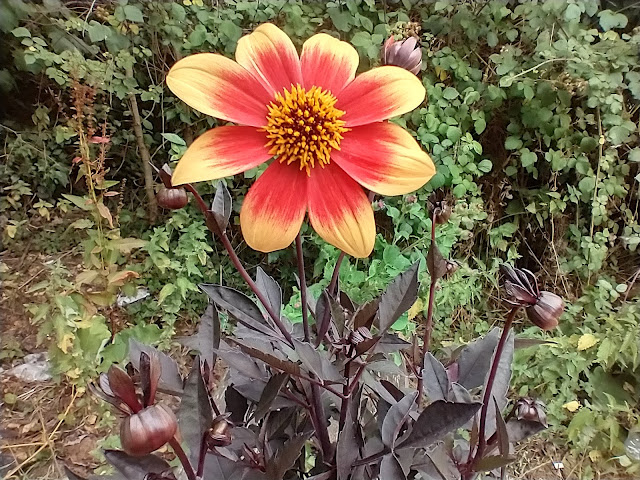Latin Without Tears: Tomato
Oops, forgot to add my regular Latin feature to last week's plant profile. As it was a long post anyway and I've found quite a bit of information, a separate post seems best.
Our word for tomato is rooted in the Aztec one, tomatl which gives us a clue to this plant's origins from the Andes in South America. We had a quiz question a couple of weeks ago: What is the Peruvian 'love apple' commonly known as? and I was relieved I had the right answer - tomato - especially as the rest of the team didn't believe me. I wonder if that's where the French Pomme d'Amour originates.
According to the British Tomato Grower's Association tomatoes have been cultivated in South America since around 700 AD. They arrived in Europe in the 16th century either via the Spanish Conquistadors, or Jesuit priests bringing them back to Italy.
According to Wikipedia, the latin name for tomato is Solanum lycopersicum, which shows it's been placed in the notorious nightshade plant family, Solanacea. The meaning of this part of the Latin name is unclear: it could refer to the similarity of the plant's flowers to the sun's rays - at least one species is known as the 'sunberry'. Or it could originate from solari, the Latin verb meaning 'to soothe', which refers to the medicinal properties of some of the species found in this family.
However, other sources such as the Plants for a Future Database give the Latin name as Lycopersicon esculentum. My findings so far suggest this genus name refers to wild tomatoes and the Solanum naming is accepted by botanists for cultivated varieties.
Whichever Latin name we're looking at, Lycopersicon and lycopersicum are derived from the Greek meaning 'wolf peach'. This could be rooted in the initial belief when they arrived in Europe that tomatoes were poisonous. Tomatoes are rich in lycopene, which is the carotenoid responsible for giving tomatoes their distinctive colour.
We now know tomatoes are edible (esculentum = edible) and delicious. They're one of the most widely grown edible crops in the world. The foliage is still deemed to be poisonous, going back to its nightshade roots.
However, I've seen a couple of references lately which cite the use of a small amount of leaves (around 2-3) in cooking to increase the tomatoey flavour in sauces. James Wong's latest book has 2 in his pasta sauce recipe and last week's edition of Saturday Kitchen had the whole vine from the packet popped into the pot for one recipe. The leaves or vine are fished out prior to serving.
How do you pronounce the word tomato? Oh, Let's Call the Whole Thing Off ;)











Nice to know how ancient they are. I love the smell of the foliage, not sure I'll be adding it to pasta sauces quite yet though.
ReplyDeleteIt takes a bit of a leap of faith doesn't it. I wonder if that's from our tribal memory re the nightshade family being poisonous. If I get a glut to make pasta sauce later this year, I'll give it a try and report back!
DeleteAnd yes, there's nothing like the distinctive smell of tomato foliage as you brush past it.
DeleteI'm thoroughly enjoying James Wong's book - I prefer scientific theory to urban myth! Is that an Indigo Rose tomato looking so tempting there on your plate? I wasn't impressed with the ones I grew last year so am giving up on them in favour of more reliable cultivars.
ReplyDeleteSame here Caro and it's been enlightening talking to James about his findings. It is Indigo Rose - I went to a talk in Bath last October and learned more about the breeding programme in Oregon - there's more to come from this line which promises to be tastier. I found this is a tomato that worked better in a sauce, just like Paolo from Franchi seeds says when he's looking at the tomato varieties they offer.
Delete